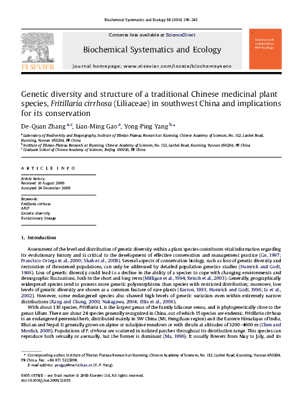NEWS 2010
Genetic diversity and structure of a traditional Chinese medicinal plant species, Fritillaria cirrhosa (Liliaceae) in southwest China and implications for its conservation
De-Quan Zhang¹, ², Lian-Ming Gao ¹, Yong-Ping Yang ²
Biochemical Systematics and Ecology 38: 236-242 (2010)
doi:10.1016/j.bse.2009.12.029
¹Laboratory of Biodiversity and Biogeography, Institute of Tibetan Plateau Research at Kunming, Chinese Academy of Sciences, No. 132, Lanhei Road, Kunming, Yunnan 650204, PR CHINA
²Graduate School of Chinese Academy of Sciences, Beijing 100039, PR China Institute of Tibetan Plateau Research at Kunming, Chinese Academy of Sciences, No. 132, Lanhei Road, Kunming, Yunnan 650204, PR CHINA
Abstract
Fritillaria cirrhosa D. Don (Liliaceae) is an endangered perennial herb, distributed primarily in SW China and the Himalayas. Its bulb, chuanbeimu (in Chinese), is an important traditional Chinese medicine that is used in antitussive, expectorant and antihypertensive drugs. In this study, amplified fragment length polymorphism (AFLP) was used to examine genetic diversity and structure of F. cirrhosa in SW China and explore the effect of human-harvesting on the wild resource at molecular level. Using two primer combinations, a total of 161 bands were generated, of which 148 (91.93%) were polymorphic. Despite overharvesting in the last decades, F. cirrhosa has maintained relatively high genetic diversity at the population level (PPB = 74.95%, H E = 0.2704, S = 0.4019). The genetic differentiation among the nine sampled populations is estimated as G ST = 0.2771 and Φ ST = 0.2533. This relatively high genetic variation could be due to its evolutionary history and special life history traits. Although human collection can result in decreased wild population number and size, it has not shown a significant loss of genetic variation in F. cirrhosa . Mantel test showed a significant relationship between genetic distance and geographic distance (r = 0.4515, p = 0.006). On the UPGMA tree, grouping of populations corresponded with floristic division. Based on findings and its reproductive features, in-situ conservation is suggested as a priority for conservation of F. cirrhosa . Scientific harvesting strategies, domestication and cultivation would improve sustainable utilization and protect this important wild resource.

